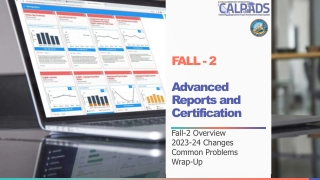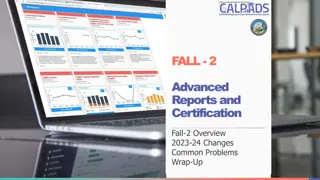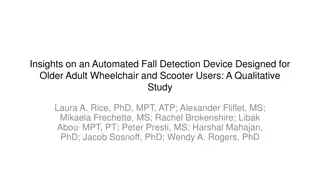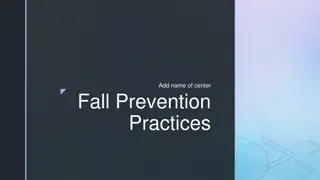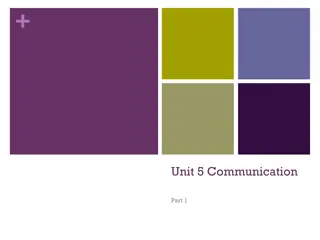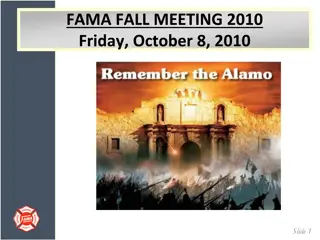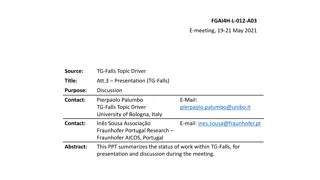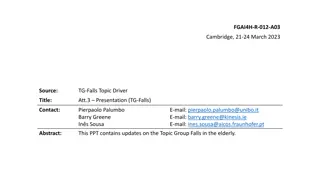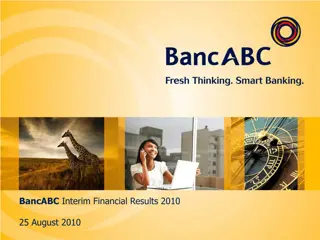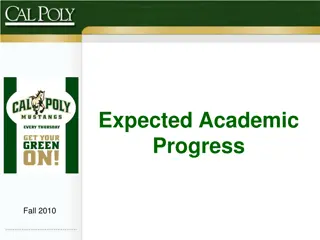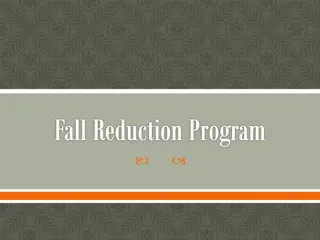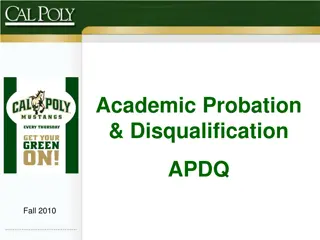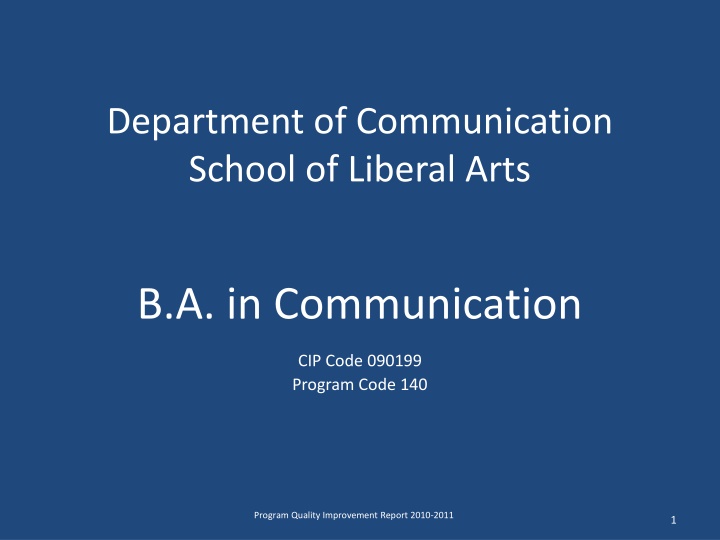
Communication Department Quality Improvement Report 2010-2011
Discover the program objectives in the Department of Communication at the School of Liberal Arts, alignment of outcomes with university and departmental missions, measures of learning outcomes, and methodologies for addressing academic shortfalls. Explore the holistic approach to enhancing student success in communication-related professions.
Uploaded on | 1 Views
Download Presentation

Please find below an Image/Link to download the presentation.
The content on the website is provided AS IS for your information and personal use only. It may not be sold, licensed, or shared on other websites without obtaining consent from the author. If you encounter any issues during the download, it is possible that the publisher has removed the file from their server.
You are allowed to download the files provided on this website for personal or commercial use, subject to the condition that they are used lawfully. All files are the property of their respective owners.
The content on the website is provided AS IS for your information and personal use only. It may not be sold, licensed, or shared on other websites without obtaining consent from the author.
E N D
Presentation Transcript
Department of Communication School of Liberal Arts B.A. in Communication CIP Code 090199 Program Code 140 Program Quality Improvement Report 2010-2011 1
Student Learning Outcomes We have 14 Program Objectives Students will be able to demonstrate the following: 1. Public speaking 8. Media graphics 2. Writing skills 9. Radio production 3. Research competency 10. TV News production 4. Critical thinking 11. Video production 5. Content knowledge 12. Broadcast writing 6. Newswriting 13. Computer literacy 7. Photography 14. Satisfaction w/ major 2 Program Quality Improvement Report 2010-2011
Holistic Alignment of Outcomes Alignment with University, School, and Departmental mission statements, and Plan 2013: [UNIVERSITY] Cameron University ... provides quality educational opportunities [and] combines innovative classroom teaching with experiential learning; prepares students for professional success [SCHOOL] The School of Liberal Arts fosters a student-centered academic environment, in keeping with the mission of the University, and is dedicated to guiding students to the highest possible standard of achievement. 3 Program Quality Improvement Report 2010-2011
Holistic Alignment of Outcomes Alignment with University, School, and Departmental mission statements, and Plan 2013: [DEPARTMENT] The Communication Department strives To offer learning opportunities that develop student intellectual capacities preparing students for graduate school or a number of communication-related professions. [Strategic Plan 2013 GOAL #1.1] Maintain and enhance Cameron s commitment to providing programs of the highest quality in instruction, research, and service 4 Program Quality Improvement Report 2010-2011
Measures of Learning Outcomes Direct measures of student learning objectives: Portfolio review [Standardized assessment rubrics] Performance review Locally developed test [knowledge] Indirect measures of student learning objectives: Graduating senior attitudinal survey IDEA Student Reactions are included in faculty reappointment Faculty Perceptions of Student Learning 5 Program Quality Improvement Report 2010-2011
Measure of Learning Outcomes Program methodologies that addresses academic shortfalls prior to graduation: [Institutionalized] None. [Non-institutionalized] Informal workshops One-on-one study sessions Group study sessions Emphasis on proper academic advisement 6 Program Quality Improvement Report 2010-2011
Program goals and objectives Each OBJECTIVE is tracked using data from a number of COMPETENCIES. Ranging from 1 to 8 COMPETENCIES COMPETENCIES are rated using a 9-pt. scale Divided into three RANGES:* Unsatisfactory 1 2 3 4 5 6 7 8 9 Satisfactory Excellent * Borrowed from NCA National Communication Association 7 Program Quality Improvement Report 2010-2011
Program goals and objectives P.O. # 11 Demonstrate* effective video production Knowledge* areas measured: Lighting, audio, camera work, graphics, editing, content and length. *Bloom s Taxonomy These areas were scored on the following four-point scale of 0-3: 0-unacceptable, 1-marginally acceptable, 2-acceptable, 3-excellent. The scale was adapted from Kohl & Wilson (1986). 8 Program Quality Improvement Report 2010-2011
Program actions since last assessment presentation 1. WRITING - Our department chose the following strategies to improve scholarly writing: Make clear the ground rules early-on as to departmental expectations [Idea development, Documentation, Grammar, etc.] - - Emphasize the depth and maturity of reasoning expected at the collegiate level. - Provide extended feedback in these areas. - Encourage students to utilize other campus writing resources [Center for Writers, library, etc.] 2008-2009 - 6.3 2009-2010 - 6.7 2010-2011 - 6.9 9 Program Quality Improvement Report 2010-2011
Program actions since last assessment presentation 2. RESEARCH - We implemented the following strategies to improve research skills: - Consider adding the Communication Research Course to the Core.* - Consider making the Communication Research Course a pre- requisite for some research based courses. - Broaden the usage of EBSCO Communication and Mass Media Utilize newly formed committee to review the PR and Speech degree structures. - 2008-2009 5.8 2009-2010 5.5 2009-2010 4.9 * New course offered Spring 2010; Curriculum proposals in progress. 10 Program Quality Improvement Report 2010-2011
Program actions since last assessment presentation 3. Video Production Since changes have been implemented, we will be looking forward to the assessment results in the next year as this is when the students who have benefited from the changes will be participating in the assessment process. So we will analyze and make changes on those results. 11 Program Quality Improvement Report 2010-2011
Program objective and measurement PO #2 - Demonstrate effective [scholarly] writing skills [PR/Org Comm emphasis] PROGRAM GOAL: MEASUREMENT OF PROGRAM OBJECTIVE Methods used to determine validity of measurement instruments Methods used to determine reliability of measurements CURRICULUM AREA OR TARGET AUDIENCE PROGRAM OBJECTIVE 1 Schedule for measurements Measurements [#2] Demonstrate effective [scholarly] writing skills Upper-division Communication Department courses. DIRECT: Portfolio review [Research paper] Standardized national assessment rubric [adapted from NCA] Multiple raters Annually [Fall] Consistent use over 15 years INDIRECT: Inter-rater reliability 12 Program Quality Improvement Report 2010-2011
Display of assessment data [N = 10 students] PO #2 - Demonstrate effective writing skills [Public relations/Organizational communication emphasis] AVE. 7.7 COMPETENCIES Statement of Purpose 6.6 Sentence structure 7.4 Organization 6.9 Development of Ideas 6.3 Grammar 6.7 Documentation 7.0 Connectives 2008-2009 - 6.3 2009-2010 - 6.7 2010-2011 - 6.9 6.9 AVE. 13 Program Quality Improvement Report 2010-2011
Program objective and measurement PO #3 - Demonstrate effective research competency [Speech Comm emphasis] PROGRAM GOAL: MEASUREMENT OF PROGRAM OBJECTIVE Methods used to determine validity of measurement instruments Methods used to determine reliability of measurements CURRICULUM AREA OR TARGET AUDIENCE PROGRAM OBJECTIVE 1 Schedule for measurements Measurements [#3] Demonstrate effective research competency Upper-division Communication Department courses. DIRECT: Portfolio review [Research paper] Standardized national assessment rubric [adapted] Multiple raters Annually [Fall] Consistent use over 15 years INDIRECT: Inter-rater reliability 14 Program Quality Improvement Report 2010-2011
Display of assessment data [N = 5 students] PO #3 - Demonstrate effective research competency [Speech Communication emphasis] AVE. 5.1 COMPETENCIES Research problem 4.8 Definition 5.0 Review of literature 5.6 Data 4.7 Analysis 4.6 Conclusions 4.6 Implications 2008-2009 5.8 2009-2010 5.5 2010-2011 4.9 4.9 AVE. 15 Program Quality Improvement Report 2010-2011
Program objective and measurement PO #11 - Demonstrate effective video production MEASUREMENTS OF STUDENT LEARNING OR SERVICE OUTCOME Methods used to determine validity of measurement instruments Methods used to determine reliability of measurements CURRICULUM AREA OR TARGET AUDIENCE PROGRAM OUTCOME Schedule for measurements Measurements Gay (1992) stipulates that validity is the degree to which a test measures what it is supposed to measure. In determining validity Gay recommends determining instrument validity for subject matter and for the person being assessed. Demonstrate* effective video production competency RTV 2313 Basic Television Production Direct Measures Portfolio Locally Developed and Validated Examinations Inter-rater reliability Annually every Fall Semester RTV 3323 Field Production and Editing Indirect Measures IDEA Student Reactions are included in faculty reappointment Exit Interviews Faculty Perceptions of Student Learning 16 Program Quality Improvement Report 2010-2011
Display of assessment data [N = 6 students] PO #11 - Demonstrate effective video production 0-unacceptable, 1-marginally acceptable, 2-acceptable, 3-excellent. Lighting Audio Camera Graphics Editing Script Content Length Student Average 2.8 1.8 2.9 2.7 3.0 2.9 2.8 2.0 17 Program Quality Improvement Report 2010-2011
Display of assessment data [N = 6 students] P.O. # 11 Demonstrate* effective video production Knowledge Area - Length RTV: Video Production PSA - Length 3 2.5 2 Rating Length Linear (Length) 1.5 1 0.5 0 96-97 97-98 98-00 00-01 01-02 02-03 03-04 Academic Year 04-05 05-06 06-07 07-08 08-09 09-10 10-11 Program Quality Improvement Report 2010-2011 18
Action plan PO #2 - Demonstrate effective writing skills [Public Relations/Organizational Communication Emphasis] Ongoing Offer the Communication Research course every year and require as a departmental core course Encourage students to utilize other campus writing resources [Center for Writers, library, etc.] Spring 2011 Communicate strict departmental guidelines [Idea development, Documentation, Grammar, etc.]; Provide extended feedback in these areas Spring 2011 19 Program Quality Improvement Report 2010-2011
Action plan PO #2 - Demonstrate effective writing skills [Public Relations/Organizational Communication Emphasis] Spring 2011 Faculty will examine rubric and examine inner-rater reliability Ongoing Emphasize the depth and maturity of scholarly writing expected at the collegiate level [in upper division courses]. Provide models of exceptional research projects/papers from previous semesters. Spring 2011 COST 1/8 Full-time faculty load to offer the research methods course once per academic year. 20 Program Quality Improvement Report 2010-2011
Action plan PO #3 - Demonstrate effective research competency [Speech Communication Emphasis] Ongoing Offer the Communication Research course every year and require as a departmental core course Have a faculty workshop to improve student research writing Spring 2011 Have faculty examine research rubric and inner-rater reliability Increase the usage of EBSCO Communication and Mass Media Ongoing Make the Communication Research course a pre-requisite for research based communication courses. 21 Program Quality Improvement Report 2010-2011
Action plan PO #3 - Demonstrate effective research competency [Speech Communication Emphasis] Communicate strict departmental guidelines [Data gathering and reporting, analysis, implications/critical judgment, etc.]; Provide extended feedback in these areas. Spring 2011 Provide models of exceptional research projects/papers from previous semesters. Spring 2011 COST 1/8 Full-time faculty load to offer the research methods course once per academic year. 22 Program Quality Improvement Report 2010-2011
Action plan PO #11 - Demonstrate effective video production Based on our data, we recommend the following: Offer remediation to graduating students who did not perform. Ongoing Develop a capstone course that will provide the atmosphere for providing serious Ongoing Reemphasize importance of producing a quality project and provide extended feedback in knowledge areas. Ongoing COST 1/8 Full-time faculty load 23 Program Quality Improvement Report 2010-2011
Ancillary Action - Provide a room for the Speech Center that is available all day - Assign the current Fundamentals of Speech instructor position to direct the Speech Center, mentor new adjuncts, and coordinate the General Education Assessment data for the department - Propose a new full-time Public Relations position to support future course offerings on campus and online - Propose a new full-time faculty member to teach Mass Communication classes and serve as Production Manager for the new television studio Program Quality Improvement Report 2010-2011 24
Published information on graduates Entered Graduate School Entered Graduate School Working In Discipline Working In Discipline Other Other Academic Year 09-10 Academic Year Summer 2009 Summer 2010 2 3 3 Fall 2009 Fall 2009 3 6 3 Spring 2010 Spring 2010 Total Total 5 9 6 25 Program Quality Improvement Report 2010-2011

